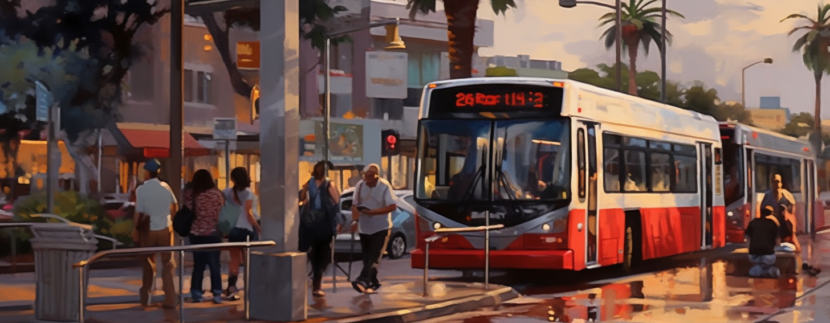The Benefit of Transit Priority Districts in San Diego

Introduction
Navigating the urban jungle of today’s metropolises calls for innovative, effective, and sustainable public transit solutions. San Diego, a city teeming with vibrant life and bustling activity, is leading the way with its Transit Priority Districts (TPDs). Let’s take a detailed exploration into this transformative development that’s reshaping San Diego’s transportation landscape.
Transit Priority Districts in San Diego: The Fundamentals
In essence, Transit Priority Districts in San Diego represent a paradigm shift in urban planning, emphasizing the importance of public transit over personal vehicles. This innovative approach aims to bolster public transportation utilization, alleviate traffic congestion, and advance environmentally conscious commuting methods. With that in mind, let’s delve deeper into the particulars of this system.
Origins of TPDs in San Diego
The birth of Transit Priority Districts in San Diego is a story of progressive thinking and innovative solutions. Inspired by an urgent need for environmental sustainability and a desire to manage growing traffic issues, TPDs were born.
Recognizing the Imperative for Transformation
San Diego, like many other vibrant cities, was grappling with an unsustainable transportation model. Escalating population levels and increasing private vehicle usage were suffocating the city’s roads. The resulting traffic congestion, coupled with the carbon footprint of these vehicles, signaled a dire need for change.
TPDs: An Out-of-the-Box Solution
Faced with these challenges, San Diego introduced the concept of TPDs, an innovative solution designed to improve public transit’s effectiveness, thus enticing residents to switch from private vehicles to public transportation options.
Operational Dynamics of TPDs
To grasp the true essence of TPDs, one needs to understand how they function. Let’s unpack the operational mechanics of these zones.
Dedicated Bus Lanes and Transit Signal Prioritization
Two critical components underpin the functionality of TPDs – dedicated bus lanes and transit signal priority. The former provides an unobstructed path for buses, while the latter offers them precedence at traffic signals, significantly reducing transit times.
Diminishing Parking Facilities
To further discourage private vehicle usage within TPDs, the city has strategically reduced parking spaces, nudging residents towards more sustainable and efficient public transit options.
Implications of TPDs
Transit Priority Districts are much more than a system of efficient bus lanes and transit signals; they are instrumental in shaping the city’s environment, influencing the residents’ commuting behavior, and paving the way for a sustainable future.
Easing City Congestion
TPDs have significantly helped decongest San Diego’s cityscape. As public transportation becomes increasingly efficient, many residents are opting to leave their cars behind and use the city’s buses, leading to less traffic on the roads.
A Green Revolution
By encouraging public transportation and reducing the reliance on private vehicles, TPDs are contributing significantly to reducing carbon emissions. It’s an environmentally conscious solution that benefits us all.
The Future Trajectory of TPDs in San Diego
Transit Priority Districts are not a passing fad but a well-conceived strategy set to influence San Diego’s future. The roadmap looks promising with plans for expansion and improved infrastructure.
Widening the Scope of TPDs
The success of existing TPDs has prompted plans for expanding these districts throughout the city. This expansion aims to bring more regions under the T
PD umbrella, thereby maximizing the benefits of this innovative transit solution.
Investing in Advanced Transit Infrastructure
San Diego also plans to invest in advanced transit infrastructure within TPDs. This includes introducing technologically advanced buses, enhancing bus stop facilities, and implementing real-time bus tracking, making the transit experience smoother for commuters.
Frequently Asked Questions
What are the primary functions of Transit Priority Districts in San Diego?
Transit Priority Districts in San Diego are designed to prioritize public transit over private vehicles through dedicated bus lanes, transit signal prioritization, and reduced parking facilities.
How do Transit Priority Districts contribute to reducing traffic congestion?
TPDs encourage people to opt for public transportation, thus reducing the number of private vehicles on the road and, in turn, easing traffic congestion.
Do TPDs contribute to environmental sustainability?
Yes, by minimizing private vehicle usage and promoting public transportation, TPDs contribute to reducing carbon emissions, making them an environmentally sustainable solution.
Are there plans for future expansion of TPDs in San Diego?
Yes, the city has plans to expand the TPD network based on the success of the existing Transit Priority Districts.
What future improvements are envisaged for TPDs?
The city plans to upgrade transit infrastructure within TPDs, including the introduction of advanced buses, improved bus stops, and real-time bus tracking facilities.
Are parking facilities restricted in Transit Priority Districts?
Yes, to encourage public transit usage, parking facilities for private vehicles are intentionally reduced within Transit Priority Districts.
Conclusion
Transit Priority Districts in San Diego embody a pioneering approach to urban transit, offering a sustainable and efficient alternative to the city’s commuting woes. While the concept may seem complex, it is a practical and beneficial solution that significantly enhances city traffic management and promotes green commuting alternatives. As urban spaces continue to evolve, TPDs offer a promising blueprint for a greener, more efficient, and congestion-free future.
